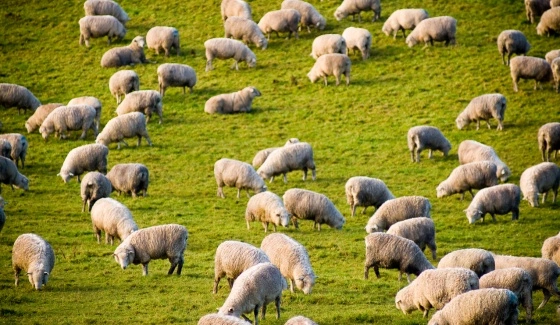
Hannaton Merinos stud master Jonno Hicks has seen the value of genetic selection in his stud and commercial flocks after one of the driest seasonal starts on record around Kaniva in Victoria’s west Wimmera region.
And the family business is set to implement more tweaks and changes, as it continues on its mission toward breeding profitable, easy-care, efficient sheep for clients and a conscientious marketplace.
The Hicks family’s Hannaton Merinos operation was one of three sites chosen to host neXtgen Agri’s Farm Fit Ewes workshops in Victoria last week.
neXtgen Agri chief executive officer and geneticist Mark Ferguson said the results of Hannaton’s selection for muscle and genetic fat could be seen in the improved carcase and condition of the sheep.
“They were shining.”
The workshop series presented targeted research and data on sheep breeding and feeding, with almost 100 producers attending to hear from Dr Ferguson and Hamilton-based sheep nutrition and breeding consultant Darren Gordon.
Jonno said his Merino and White Suffolk ram-breeding operation, which also runs 1400 Merino ewes and joins around 500 Merino ewe lambs annually, is constantly seeking evolution in type through trait selection.
“If you want to improve something in your sheep, you need to measure it,” Jonno said. As well as a commercial self-replacing Merino flock and prime lambs, Hannaton also does broadacre cropping of canola, wheat, beans and barley, and grows vetch for hay production.
All stud lambs are run in one management group for ewes and rams from weaning until 12 months of age to identify top animals based on their production rather than their management.
“Our clients really encouraged us in the direction of Australian Sheep Breeding Values initially, and we’ve seen some huge value in the figures as well as visual selection.
“It is important to use both, but in a year like this one – there’s nowhere to hide, and the figures really show the true genetic potential of the animals,” Jonno said.
Hannaton is committed to early adoption
Over its 102-year history, Hannaton has developed a strong commitment to early adoption; sourcing top genetics using laparoscopic artificial insemination since 1983 and Optical-based Fibre Diameter Analyser (OFDA) testing.
In the years since Jonno returned home from Marcus Oldham in 2010 to take the role of stud master, the family has started using electronic identification (EID), shifted from around 80:20 (horned to poll) rams to 100 percent poll, and delved into in-depth performance recording – offering all sale rams with MERINOSELECT ASBV’s.
“With the use of EID, all stud lambs are now measured for growth rate from weaning to yearling, eye muscle and fat depth, as well as individual fleece weight, fleece value and staple length.
“Another of the exciting tools we are using more and more in the stud is DNA testing,” he said.
All Hannaton sires have been genomics DNA-tested since 2013 and now top sale rams and elite ewes are being tested.
“The test predicts genomic breeding values based on DNA markers for 20 different traits in Merinos.
These genomic test results are combined with data in Sheep Genetics, using single step analysis, to increase the accuracy of ASBVs and help us and our clients make more informed breeding decisions.”
Since engaging neXtgen Agri, Jonno said he’s excited about the potential benefits in focusing on lifting muscle, fat and growth as a focus across the flock.
Going forward, the operation also plans to phase out mulesing.

“We see this as meeting the consumer and market expectation; and responding to the desire for ethically produced fibre,” Jonno said.
“We are also looking more at joining ewe lambs, having had mixed success on this front in the past.
“The workshop reinforced the importance of pre-joining management in ewes, and feeding to condition score targets…along with the underpinning of an open mindset, and an interrogation of the business in terms of what will make money, save money and save time,” he said.
“Having done the Lifetime Ewe Management course, the workshop was a timely reminder of principles around lambing and weaning in tough seasons like this one, where we were 100 percent supplementary feeding in the first three to four weeks of lambing.”
Going forward, Jonno said he’s keen to learn more about hereditability of traits and continue taking Hannaton clients on a journey with the stud.
“Seeing the genetic progress in our sheep and our client’s sheep gives us the greatest satisfaction.
“Our rams have been performing well in industry trials and our clients have been winning wether trials and topping wool and off shear sales.”
“I think the industry as a whole is moving in the right direction, but there is still some disjointedness.
“I believe there’s huge value in figures as well as visual selection, and coming from a crop business as well – we understand the motto ‘you can’t manage what you don’t measure,’ so we look forward to continuing the journey of trait selection across the Hannaton flock,” Jonno said.
Dr Ferguson said about 90 producers have attended the first three Farm Fit Ewe workshops at Burnbrae near Inverleigh, Hannaton and Firgrove Pastoral at Moutajup.
He said the workshops have updated producers on Lifetime Ewe Management course material, focusing on energy budgets and take home actions. He said the value of the workshops would flow on with follow-up consultations with participants and access to online tools.
This Article was originally published on Sheep Central. Please click here.




.jpg)




